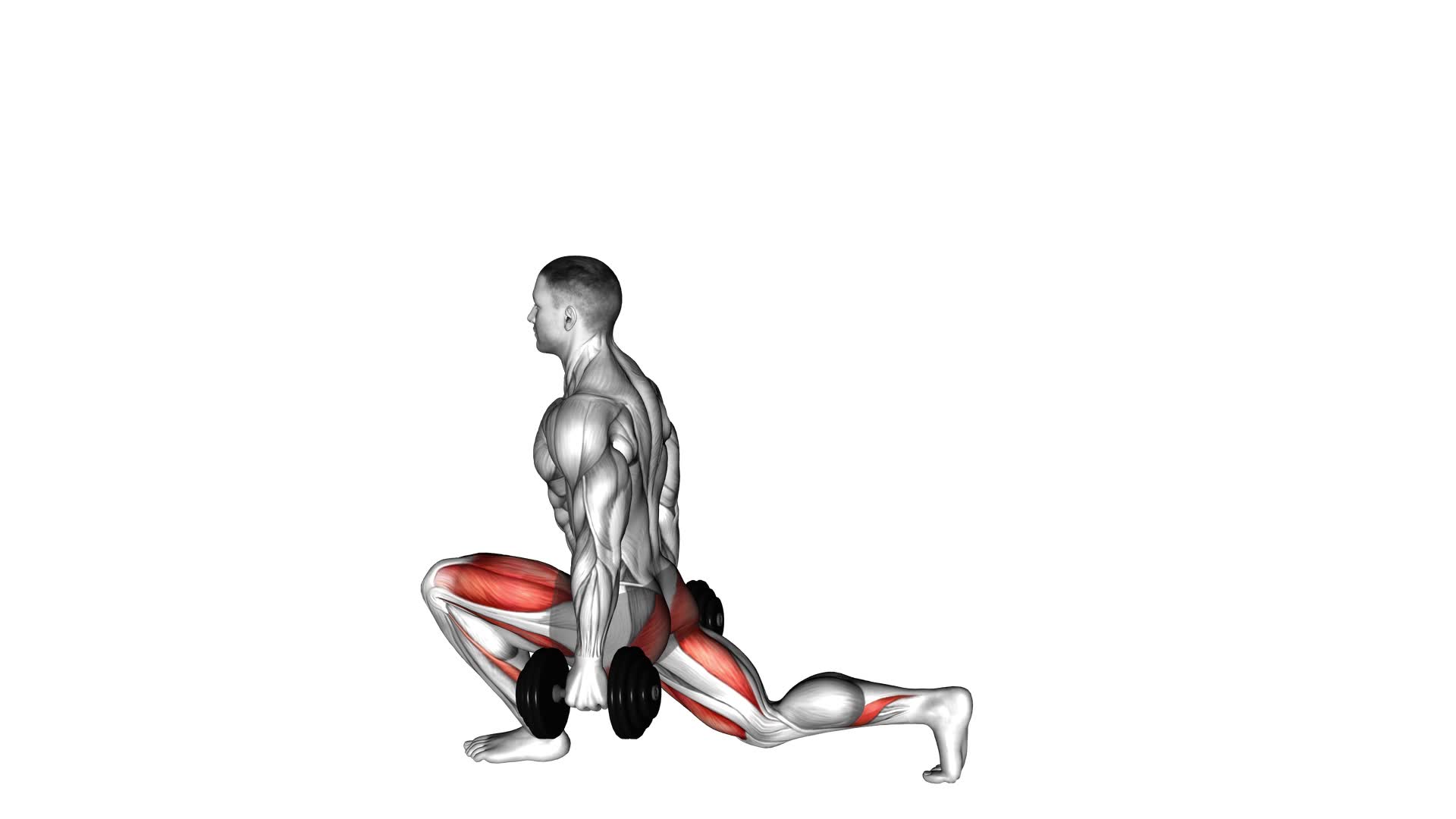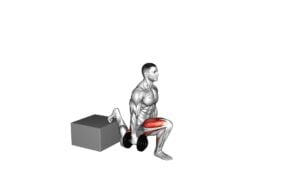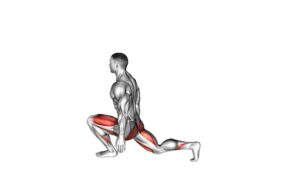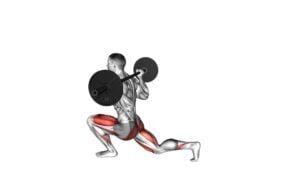Dumbbell Low Split Squat (male) – Video Exercise Guide & Tips

Looking to build stronger legs and improve your lower body strength? The dumbbell low split squat is a fantastic exercise choice.
Watch This Exercise Video
This video exercise guide and tips will show you the proper form and technique, as well as how to increase intensity and avoid common mistakes.
Get ready to maximize your results and get the most out of every rep with this effective exercise.
Let's dive in!
Key Takeaways
- Targets muscles in the legs, including quadriceps, hamstrings, glutes, and calves
- Engages upper body muscles, such as shoulders, arms, and core
- Improves balance and coordination
- Increases hip and ankle mobility
Benefits of the Dumbbell Low Split Squat
The dumbbell low split squat offers a range of benefits for individuals looking to improve lower body strength and stability. This exercise primarily targets the muscles in your legs, including the quadriceps, hamstrings, glutes, and calves. By incorporating dumbbells into the exercise, you can also engage your upper body, specifically your shoulders, arms, and core. This compound movement not only strengthens your muscles but also improves balance and coordination.
One of the key benefits of the dumbbell low split squat is its versatility. There are several variations you can try to target different muscle groups and add variety to your workout routine. For example, you can perform the exercise with your back foot elevated on a step or bench, which will increase the activation of your glutes and hamstrings. Alternatively, you can hold the dumbbells in a different position, such as at your sides or in a goblet grip, to challenge your muscles in different ways.
Another benefit of this exercise is that it can be modified to suit different fitness levels. If you're a beginner, you can start with bodyweight only and gradually add dumbbells as you become stronger and more comfortable with the movement. On the other hand, if you're more advanced, you can increase the weight of the dumbbells or incorporate other equipment, such as a stability ball or resistance bands, to make the exercise more challenging.
Proper Form and Technique for the Dumbbell Low Split Squat
To perform the dumbbell low split squat correctly, stand with your feet shoulder-width apart. Here are some important tips to help you maintain proper form and technique for this exercise:
- Step forward with one leg and lower your body by bending both knees. Keep your front knee directly above your ankle and your back knee hovering just above the ground.
- As you descend, maintain an upright posture and engage your core muscles to stabilize your body.
- Push through your front heel to return to the starting position, focusing on using your glutes and quadriceps to drive the movement.
- Keep your upper body straight throughout the exercise, with your shoulders back and chest lifted.
Improving balance: To challenge your balance further, you can try performing the dumbbell low split squat on an unstable surface, such as a balance board or Bosu ball. This will engage your stabilizer muscles and enhance your overall balance.
Variations and modifications: To make the exercise more challenging, you can increase the weight of the dumbbells or perform the movement explosively, incorporating a jump when returning to the starting position. Alternatively, if you're a beginner or have any knee issues, you can perform the exercise without weights or use a support, such as a chair or wall, to assist with balance and stability.
Increasing Intensity and Progression for the Dumbbell Low Split Squat
To increase the intensity and progression of the dumbbell low split squat, you can incorporate added resistance and adjust the range of motion. One way to add resistance is by increasing the weight of the dumbbells you're using. Start with a weight that challenges you, but allows you to maintain proper form throughout the exercise. As you become stronger, gradually increase the weight to continue challenging your muscles.
Another progression technique is to adjust the range of motion. Instead of lowering your back knee to the ground, you can lower it halfway or even just a few inches off the ground. This will increase the demand on your muscles, especially your quads and glutes. Make sure to maintain good balance and control throughout the movement.
Variations and modifications can also be incorporated to increase the intensity of the dumbbell low split squat. For example, you can perform the exercise on an unstable surface, such as a Bosu ball or a foam pad. This will engage your core muscles even more as they work to stabilize your body during the exercise.
Additionally, you can try performing the exercise at a slower tempo, focusing on the eccentric (lowering) phase of the movement. This will further challenge your muscles and increase the time under tension.
Common Mistakes to Avoid During the Dumbbell Low Split Squat
When performing the dumbbell low split squat, be careful to avoid these common mistakes:
- Improper alignment: Make sure your front knee is directly above your ankle and not extending past your toes. Keep your back leg straight and in line with your hip.
- Lack of stability: Ensure that your feet are shoulder-width apart and firmly planted on the ground. Engage your core to maintain balance throughout the exercise.
- Incorrect weight distribution: Distribute your body weight evenly between your front and back legs. Avoid leaning too far forward or backward, as it can lead to strain on your joints.
- Insufficient depth: Descend into a deep squat position, ensuring that your front thigh is parallel to the ground. This will engage your glutes, hamstrings, and quads effectively.
By avoiding these common mistakes and maintaining proper form, you can maximize the benefits of the dumbbell low split squat.
Remember to start with lighter weights and gradually increase as you build strength and confidence in your technique.
Tips for Getting the Most Out of the Dumbbell Low Split Squat
To maximize the benefits of the dumbbell low split squat, consistently focus on proper form and technique. This exercise primarily targets the quadriceps, hamstrings, and glutes, but it also engages the core for stability. Here are some tips to help you get the most out of this exercise:
- Maintain a neutral spine: Keep your back straight throughout the movement to avoid unnecessary strain on your lower back. Engage your core to support your spine.
- Control your descent: Lower yourself slowly and with control, ensuring that your front knee stays in line with your ankle and your back knee hovers just above the ground. This will engage your muscles more effectively.
- Use proper foot placement: Position your front foot far enough forward so that your knee doesn't extend past your toes when you lower into the squat. Your back foot should be placed on the ball of your foot for stability.
Common modifications for the dumbbell low split squat include using a lighter weight or no weight at all, or using a bench or step to elevate your back foot. Alternative exercises that work similar muscle groups include lunges, Bulgarian split squats, or step-ups.
Remember to consult with a fitness professional if you have any concerns or limitations.
Frequently Asked Questions
How Many Sets and Reps Should I Perform for the Dumbbell Low Split Squat?
When it comes to the dumbbell low split squat, the number of sets and reps you should perform depends on your fitness level and goals. It's recommended to start with 2-3 sets of 8-12 reps per leg.
This exercise targets your lower body, particularly your quads, glutes, and hamstrings. By incorporating the dumbbell low split squat into your routine, you can improve lower body strength, stability, and balance.
Can I Replace the Dumbbells With Other Equipment for This Exercise?
Yes, you can replace the dumbbells with other equipment for the dumbbell low split squat exercise. However, it's important to note that using dumbbells offers certain benefits.
Dumbbells provide added resistance, helping to strengthen your muscles and improve your balance. They also allow for a wider range of motion, targeting different muscle groups.
While alternative equipment can be used, incorporating dumbbells into your workout routine can maximize the effectiveness of the exercise.
Is It Recommended to Do This Exercise on a Specific Surface, Such as a Mat or a Cushioned Floor?
It is recommended to do the dumbbell low split squat on a specific surface, such as a mat or a cushioned floor. Using a mat or cushioned floor provides several benefits for this exercise.
Firstly, it offers added support and comfort, reducing the impact on your joints.
Secondly, it helps to maintain proper form and technique by providing stability and preventing slipping.
Lastly, it can help protect your flooring from any potential damage caused by the weights.
Can I Incorporate the Dumbbell Low Split Squat Into a Full-Body Workout Routine?
Incorporating the dumbbell low split squat into your full-body workout routine can be a great way to work multiple muscle groups at once. This exercise targets your lower body, including your quads, hamstrings, and glutes.
To add variations for individuals with knee or hip issues, you can try using lighter weights or performing the exercise without weights. It's important to listen to your body and modify the exercise to suit your needs.
Are There Any Modifications or Alternatives for Individuals With Knee or Hip Issues?
If you have knee or hip issues, there are modifications you can make to the dumbbell low split squat. Instead of using dumbbells, you can try using a resistance band or simply perform bodyweight split squats. These modifications can help reduce the stress on your joints while still targeting your lower body muscles.
The dumbbell low split squat is a great exercise for building lower body strength, improving balance, and increasing hip mobility.
Conclusion
In conclusion, the dumbbell low split squat is a highly effective exercise for targeting the lower body muscles. By maintaining proper form and technique, you can maximize the benefits of this exercise and avoid common mistakes.
Additionally, increasing intensity and progression over time will help you continue to challenge your muscles and see progress. By following these tips and incorporating the dumbbell low split squat into your workout routine, you can achieve great results in strengthening and toning your legs and glutes.

Author
Years ago, the spark of my life’s passion ignited in my mind the moment I stepped into the local gym for the first time. The inaugural bead of perspiration, the initial endeavor, the very first surge of endorphins, and a sense of pride that washed over me post-workout marked the beginning of my deep-seated interest in strength sports, fitness, and sports nutrition. This very curiosity blossomed rapidly into a profound fascination, propelling me to earn a Master’s degree in Physical Education from the Academy of Physical Education in Krakow, followed by a Sports Manager diploma from the Jagiellonian University. My journey of growth led me to gain more specialized qualifications, such as being a certified personal trainer with a focus on sports dietetics, a lifeguard, and an instructor for wellness and corrective gymnastics. Theoretical knowledge paired seamlessly with practical experience, reinforcing my belief that the transformation of individuals under my guidance was also a reflection of my personal growth. This belief holds true even today. Each day, I strive to push the boundaries and explore new realms. These realms gently elevate me to greater heights. The unique combination of passion for my field and the continuous quest for growth fuels my drive to break new ground.







